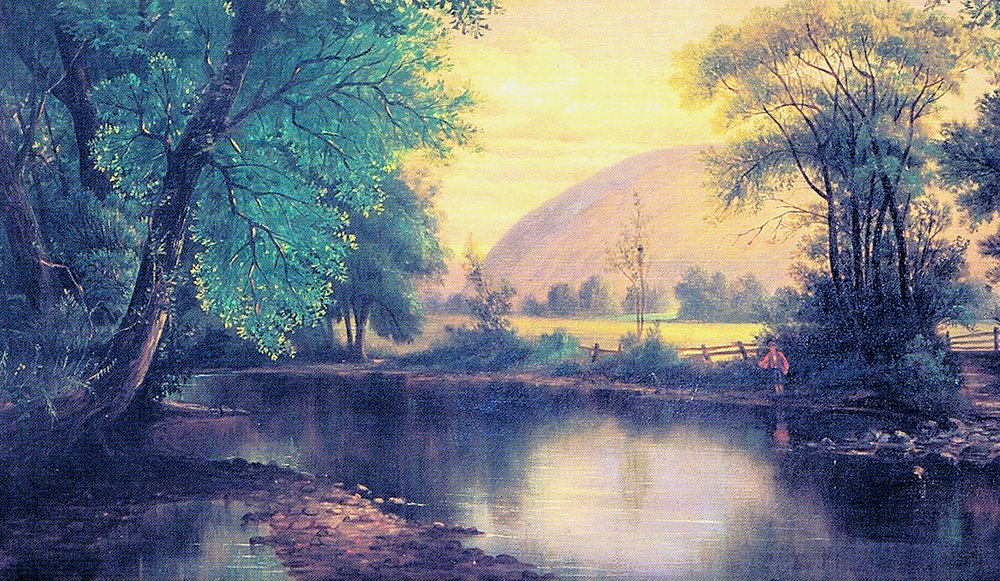
A view of the shore of Quassaick Creek painted by Newburgh artist, Thomas B. Pope.
By Mary McTamaney
The continuing threat of the coronavirus pandemic has curtailed most summer vacation plans. No one is going off on an Alaskan cruise nor a trip “down the shore” to a breezy, crowded boardwalk along an Atlantic Ocean beach. Public pools still may not open and the delight of splashing through a week or two in summer camp is unlikely for local children.
There are local spots open, however, to at least walk and run and fish and imagine the summers our forebearers spent with only Mother Nature as their recreation director. A Newburgh family of 1870 might have taken an evening walk around a local lake, bringing along a basket of supper food. A restless pair of brothers might have walked to the creek with their fishing poles. Paths crisscrossed the local woods and provided countless shady resting places for friends to walk and talk over the events of the week as they sat on a big rock or fallen tree trunk. Cemeteries were usually cool and quiet and were a favored spot for contemplation or for apartment-dwelling families to do a bit of gardening by tending their family graves.
Newburgh still has a few such places but once it had many that were fully accessible to young and old. Through the 1920’s five cent trolley service carried folks out to Algonquin Park to enjoy the many woodland trails and small millponds. Some remember summer day hikes to Harrison and Gore Pond (formed to power old woolen mills) behind Chestnut Street School or to Crystal Lake just off Temple Avenue and Miller’s Pond beyond it in the area once called “Pochuck.” Stewart’s Brookside Pond sat behind Broadway, northwest of Big Scot (the early department store that is now Newburgh Emporium) and gave its name to the long-gone Brookside Drive-In Theater. Like Crystal Lake, it was once a well-used site for winter ice harvesting but a fun place to fish in the summer. There was another pond on North Plank Road where Shop Rite now sits and across the road was little Grimm’s Pond along the Gidneytown Creek.
The Gidneytown and Quassaick Creeks flow through the town and city of Newburgh until they meet at a location long called “New Mills” (the west end of Broadway) and join to flow to the Hudson as the Quassaick Creek. Wherever a little stream was, to relieve the stress of a hot summer day, there was nothing like crouching by the rushing water and floating leaf boats and turning stones to look for crayfish.
Before our time, in the nineteenth century, Newburgh had even more small ponds to sit beside and springs to visit for a cool drink on a hot day. The southwest corner of the intersection of Broadway and Lake Street was once a pond called Poll Rose’s Pond at least through the 1840’s. The best public spring in the village was on Clark Street near Saint George’s Cemetery under the site of the former Washington Street School. Newburgh’s first hardworking villagers walked there for buckets of fresh, cold water. Spring Street gets its name from serving the same purpose a couple of blocks downhill. Those two springs and the brooks surrounding them formed a natural little pond between Ann and Washington Streets east of Clark. Before the man-made Polly, the land that became Downing Park had a small pond on its Dubois Street side just north of Third Street. It emanated from another spring named Highland Spring in the years before the Civil War and beside that pond was the Highland Spring Starch Factory. Imagine exiting Mount Saint Mary College to a big splash as your car rides into another pond. Until the 1880’s, one sat where Willett Avenue is now and covered the lots of about 15 present homes. Another pond existed down near Montgomery Street on the east side of Highland Gardens, the Andrew Jackson Downing estate. So many brooks ran through Newburgh that there was even a small reservoir built in the 1840’s uphill behind Liberty Street in the vicinity of today’s Chambers Street.
In this 21st century, we must be vigilant about safety and pollution and private property. We can’t all roam Newburgh the way our grandparents did. If you are in range of a natural water feature today, cherish it and visit it at least once during this long hot summer for a moment of refreshment.